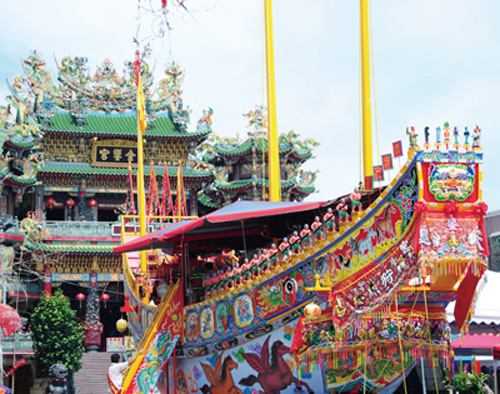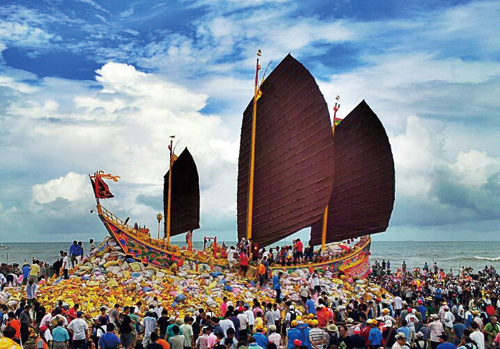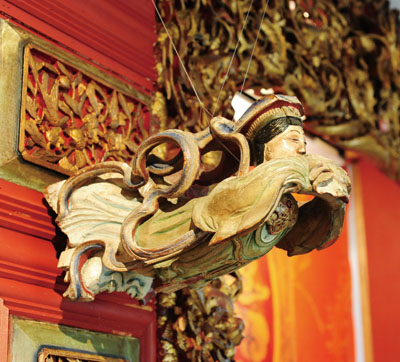Jin Luan Taoist Temple's Special Dedication Ceremony Honoring the Goddess Mazu/闊別12年 茄萣金鑾宮建醮大典
Jin Luan Taoist Temple's Special Dedication Ceremony Honoring the Goddess Mazu
◎English translation: Peng Hsin-yi
◎Photos courtesy by Pao Chung-hui, Jin Luan Taoist Temple
The name Mazu may be unfamiliar to those not well versed in Taiwanese folklore, but in Taiwan, and in many coastal Chinese-speaking communities, she is the omnipotent Holy Mother who protects and guides. Mazu, the patron goddess of seafarers, is indeed the most prominent deity in Kaohsiung City's coastal Cieding District. Local residents often greet each other with the question: "Have you paid your respect to the Holy Mother today?" The principal Mazu shrine in Cieding is Jin Luan Taoist Temple. Established in 1778, the site has been a residence of Her Ladyship for the past 234 years. It has been the center of social life, a place for prayers, reflections and solace –and also a place for celebration. In May and June 2012, the Jin Luan Taoist Temple was surrounded with an aura of extra festivity because of a special dedication ceremony. The normally spacious courtyard was cramped with a huge "Flagship," devotees' enthusiasm doubled, and the temple was crowded with visitors every day. The excitement was palpable, as this was no ordinary event. In fact, a celebration of this magnitude had not happened for twelve years.
 In the old days, dedication ceremonies took place in the spring and the fall, at the beginning and end of the farming cycle. Today, they take place at irregular intervals, and the focus of these ceremonies has changed from asking Mazu to ensure good harvests to praying for the people's well-being and prosperity. The initiation and preparation of a dedication ceremony to Mazu is conducted through a serious of elaborate processes, said Jin Luan Taoist Temple's head usher, Mr. Syue Jhao-syuan. This time round, the ball starting rolling when someone came to the temple seeking Mazu's advice. While trying to discern her will by tossing the wooden blocks –a means of divination that involves casting a pair of crescent-shaped wooden blocks on the floor –a rare "vertical pair" resulted. Because wooden blocks almost always land lengthways, not on their tips, additional questions were put to the goddess. After further inquiry, it was determined that Her Ladyship desired a special dedication ceremony.
In the old days, dedication ceremonies took place in the spring and the fall, at the beginning and end of the farming cycle. Today, they take place at irregular intervals, and the focus of these ceremonies has changed from asking Mazu to ensure good harvests to praying for the people's well-being and prosperity. The initiation and preparation of a dedication ceremony to Mazu is conducted through a serious of elaborate processes, said Jin Luan Taoist Temple's head usher, Mr. Syue Jhao-syuan. This time round, the ball starting rolling when someone came to the temple seeking Mazu's advice. While trying to discern her will by tossing the wooden blocks –a means of divination that involves casting a pair of crescent-shaped wooden blocks on the floor –a rare "vertical pair" resulted. Because wooden blocks almost always land lengthways, not on their tips, additional questions were put to the goddess. After further inquiry, it was determined that Her Ladyship desired a special dedication ceremony.
The dedication ceremony took months to prepare. Locals were mobilized as early as November 2011, and many Cieding natives who live in other parts of Taiwan returned to their hometown in order to join the ceremony. There was a procession consisting of more than 100 different groups, each of them validated by Mazu herself via tossing the jiao. The most noteworthy was the famous "centipede array," a marching routine performed by 60 local children which is somewhere between a military exercise and a dance.
Another highlight was the tour of the "Flagship." This ship –constructed of fine wood, and measuring 21.21 meters in length and 1.76 meters in height –was lavishly decorated with paintings of mythical creatures and religious symbols, and bedecked with colorful banners with embroideries, ribbons, tassels, and sequins. Five elaborate flags flew at the bow, symbolizing the five elements, while a sculpture of lion with a sword in its mouth was fixed to the stern. It is believed the presence of the lion repels evil spirits and calms unruly winds.
A series of special rites commenced, and the flagship was launched from its docking place. A feast was offered, then the ship was taken on a tour of the district with selected escorts. The procession ended with a climatic sending-off, when the vessel was set ablaze, symbolizing its departure to the realm of the gods. Mr. Syue said the flagship was constructed by local artisans with utmost care. No expense or effort was spared, because it was an expression of respect and devotion to their most beloved guardian goddess.
The dedication ceremony is a superb example of how everyday life embodies culture and religion, and how the exact details of religious ceremonies evolve as time goes by.  These activities unite people with their neighbors and their hometown, and this way of life is shared and passed down from one generation to the next.
These activities unite people with their neighbors and their hometown, and this way of life is shared and passed down from one generation to the next.
This ceremony was carefully documented by Kaohsiung Museum of History, who now have a complete record of the entire ceremony and the techniques used to build the flagship. The documentary will be submitted to a national committee as a candidate for classification as a National Important Folk Activity.
闊別12年 茄萣金鑾宮建醮大典
◎文/侯雅婷
◎照片提供/鮑忠暉、金鑾宮
走在沿海茄萣區下茄萣金鑾宮一帶,迎面走來的居民互道問候,語必提及:你到聖母/聖媽(媽祖)那去拜拜嗎?金鑾宮為當地民眾生活和信仰中心,信奉主神媽祖,234年來,慈祥的媽祖鎮守著金鑾宮,也庇佑著地方。今年的5月至6月間,下茄萣洋溢著家有喜事的氣氛,金鑾宮廟前廣場矗立起一艘巨型王船,船長21.21公尺、船高1.76 公尺,船頭飄揚著五行旗,船尾設置「獅咬劍」的精緻雕刻,象徵驅邪、鎮風煞,廟前熙來攘往的人潮格外熱鬧、忙碌,探究原因,創立於1778年的金鑾宮,闊別12年,再度舉辦建醮大典。
地方一等一的大事 建醮活動
為了籌備這場建醮大典,下茄萣1萬多位居民總動員,早在建醮活動舉辦的去年(2011年)11月起就開始忙碌了起來,參與建醮大典組織動員規模龐大,包括返鄉投入活動的異鄉遊子、茄萣區全區和臨近廟宇都參與之外,還有下茄萣當地超過100團的陣頭共襄盛舉,包括當地最知名的蜈蚣陣,由當地60位小朋友參加演出,演出腳本和飾演的角色都一一請示媽祖。
建醮大典與歷史發展密不可分,早期的農業社會定期舉辦「春祈」和「秋謝」,演變到後來不定期舉辦的建醮活動,其最大的意義是普渡眾生,同時祈求人間安寧,風調雨順。
何時舉辦建醮大典依循媽祖指示!廟方人員薛兆軒組長說明,信徒透過「擲筊」儀式請示媽祖指點迷津時,意外出現「豎筊」時(即半月形的筊,直立在地上時)象徵媽祖傳遞旨意的特殊現象,經過審慎請示媽祖,廟方才正式宣佈準備籌辦建醮大典,這也讓這場建醮大典格外地令人引頸期盼。
在一系列的建醮大典,包括王船出廠、宴王、遊境內(繞境)和送王(燒王船) 等,大王船最受各界矚目,薛兆軒表示船體由原木打造,雕刻到船身彩繪,做工精緻,全都由在地工匠一手包辦,象徵對媽祖的虔誠。
建醮大典結合在地文化和信仰,激盪出在地文化豐沛而生動的能量,更重要的是讓人與人的關係更緊密的連結,文化傳承在這像呼吸一般的自然。
高雄市歷史博物館也派員紀錄此次金鑾宮的建醮大典和王船製作技術保存,希望能通過審議委員會審核登錄,有機會躋身國家級重要民俗活動之列。
 |
Jin Luan Taoist Temple Folk Art Museum
If you visit the Jin Luan Taoist Temple, be sure you tour the Jin Luan Taoist Temple Folk Art Museum. It has an extensive collection of Mazu-related art works and artifacts, such as an altar table with elaborate carvings on its body and very rare koji pottery tiles for the table's top.
金鑾宮文物館
如果您到金鑾宮一遊,千萬別錯過館藏豐富的金鑾宮文物館,館內珍藏的神桌,栩栩如生的雕刻圖像,非常精緻,桌面還以罕見的跤趾燒磚塊拼貼圖形,讓人大飽眼福。
|